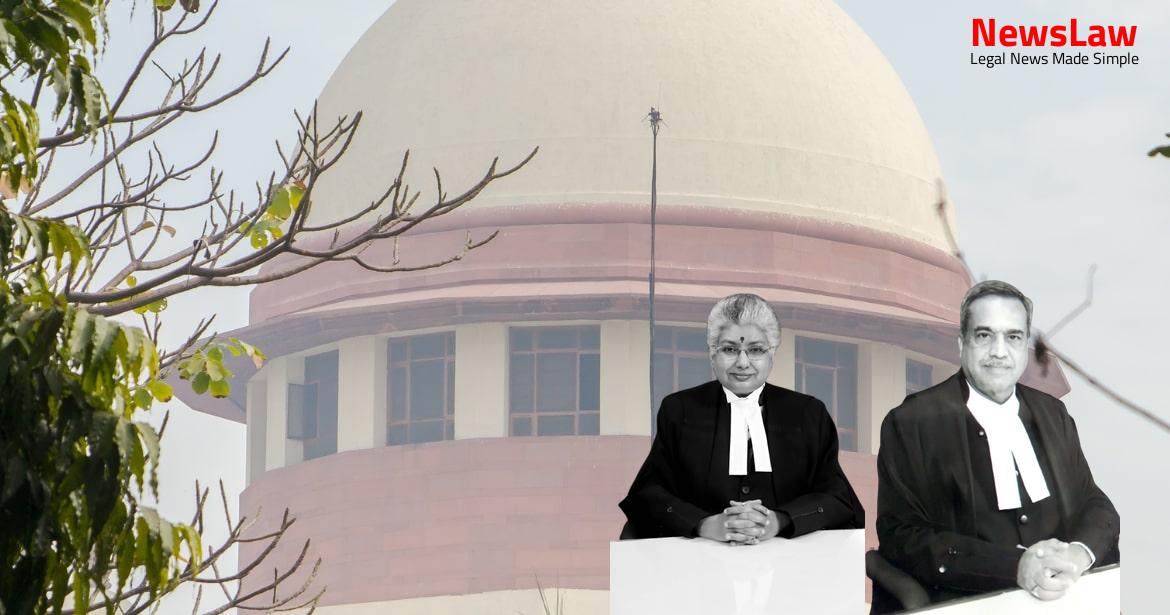Explore the in-depth legal analysis of a crucial land acquisition and development dispute where the High Court scrutinizes the implications of acquiring unsuitable land reserved for public purposes. The case sheds light on the importance of adhering to statutory provisions, the usability of reserved land, and the financial constraints faced by the Municipal Corporation. Discover the legal intricacies and considerations involved in this complex legal battle.
Facts
- The High Court issued a writ of Mandamus directing the Kolhapur Municipal Corporation to acquire the land in question under the Act of 2013.
- Kolhapur Municipal Corporation filed an application for the original petitioners to accept TDR instead of monetary compensation, which was rejected by the High Court.
- The dispute involved land owned by the original writ petitioners located in Kolhapur.
- The High Court directed the Special Land Acquisition Officer to communicate the required amount to be deposited by the Municipal Corporation for issuing a declaration under Section 19 of the Act of 2013.
- The High Court specified the timeline for depositing the requisite amount and issuing the declaration under the Act of 2013.
- The High Court rejected the plea for accepting TDR in lieu of monetary compensation as the original writ petitioners did not consent.
- The Municipal Corporation submitted that acquiring the land for a huge sum of Rs. 43,41,29,400 was not feasible.
- Development on the land was necessary for the Corporation to utilize it for the reserved purpose.
- Proposals were made for Transferable Development Rights (TDR) in lieu of compensation.
- Correspondence took place between the parties regarding the TDR proposal.
- The reserved land was flood-affected, with a rivulet named ‘Jayanti Nala’ passing through it.
- The Corporation stated that development work by the landowners was required to make the land suitable for public use as per the reservation.
- The Corporation highlighted financial constraints in paying the compensation amount and following the Development Control Rules for TDR issuance.
- The reserved land was within the High Flood Line and subject to annual flooding during the rainy season.
- The Corporation was asked to deposit 25% of the compensation amount before certain stages of land acquisition.
- Lapsed reservations were a point of contention under Section 127 of the MRTP Act.
- The land Acquisition Act of 1894 was repealed upon the enactment of the Act of 2013.
- Efforts were made to reduce the compensation amount due to financial constraints and flood-affected status of the land.
- The Corporation emphasized the necessity of completing developments for the land to serve its reserved purpose.
Also Read: Ruling on Circumstantial Evidence in Murder Case
Issue
- The main issue before the Court is whether a writ of Mandamus can be issued by the High Court to direct the Municipal Corporation to acquire land reserved for a specific purpose and pay compensation to the original landowners.
- The reservation of the land is deemed to have lapsed due to statutory provisions.
- The land directed to be acquired and compensated for is unsuitable and unusable for its reserved purpose.
- The respondents, original landowners, filed a writ petition seeking mandamus to publish a final notification under relevant Acts and to direct the Corporation to deposit compensation with them.
- The relief sought includes specific directions for publication of notifications and compensation payment.
Also Read: Challenging Legal Presumptions in Negotiable Instrument Cases
Arguments
- The Corporation contends that it is their duty to make necessary provisions for public purposes in the Development Plan.
- The Corporation argues that the land in question, which was reserved for over ten years, is unsuitable and unusable due to being flood-affected.
- It is mentioned that a rivulet named ‘Jayanti Nala’ passes through the land, making it unfit for the intended public purposes.
- The Corporation points out that the land falls within a High Flood Line, getting flooded during the rainy season annually.
- They argue that without significant development efforts, the land cannot be utilized for its designated public purposes.
- The appellant Corporation highlights a potential misuse of power if land unsuitable for development is compulsorily acquired upon reservation.
- The Corporation raises concerns about financial constraints in acquiring the land, citing a budget of only Rs. 21 crores for land acquisition against a compensation amount of Rs. 62.5 crores.
- The Corporation emphasizes the impracticality of paying such a substantial compensation for land deemed unsuitable and non-usable.
- The Corporation asserts that they had initially offered Transfer of Development Rights (TDR) as compensation but were met with opposition from the landowners due to discrepancies in rates prescribed by the Development Control Regulations (DCR).
- Respondents are willing to accept TDR in lieu of compensation for the reserved land to be acquired.
- TDR for a non-congested area is 1:2 as per Clause 11.2.4(a).
- Respondents are ready to accept TDR despite a higher cut, as they are unable to undertake construction work.
- Offered TDR ratio is 1:1.85 instead of 1:2 due to the land characteristics and constraints.
- Corporation has already granted TDR to respondents as per Unified DCPR, 2020 for acquiring the reserved land.
- Quantum of TDR is reduced to 1:1.85 in case levelling of land and construction of compound wall is not feasible.
Also Read: Legal Analysis Critique in High Court’s Quashing Order
Analysis
- The court analyzed the provisions of Sections 126 and 127 of the MRTP Act, 1966, focusing on the steps required for land acquisition.
- It was emphasized that mere passage of a resolution or making budgetary provisions is not sufficient to qualify as taking steps towards acquisition under Section 127.
- The importance of considering the suitability and usability of the land reserved for public purposes before acquisition was highlighted.
- The court discussed the repercussions of compelling authorities to acquire unsuitable land, stressing the financial burden and potential misuse of power.
- The significance of adhering to the time limits for land acquisition as stipulated in the Act was underscored.
- Special attention was given to the requirement that land reserved should be usable for the designated public purpose.
- The court deliberated on the consequences of designating unsuitable land for public purposes and the implications of such actions on landowners.
- The need for a holistic approach in interpreting the provisions to prevent misinterpretation and protect the rights of landowners was discussed.
- The Planning Authority has the duty to prepare a draft Development Plan and submit it to the State Government for sanction within the specified period.
- Section 22 of the Act, 1966 outlines the contents that should be included in the Development Plan.
- The Development Plan should have provisions for various public purposes, such as allocation of land for residential, industrial, commercial, and recreational purposes.
- It should also include designations for public purposes like schools, medical institutions, markets, and cultural institutions.
- Other aspects to be covered in the Development Plan include areas for open spaces, transport and communications, water supply, preservation of natural scenery and heritage buildings, flood control, etc.
- If land reserved for public purposes is not acquired within ten years, it will be deemed to have lapsed and released for development.
- The State Government must be notified if reservation of any land lapses.
- Procedures for acquiring land for public purposes as specified in the plans are laid down in Section 126 of the Act.
- It includes acquisition by agreement, payment of market value, and notification by the Government upon lapsing of reservations.
- If a declaration for land acquisition is not made within the specified period, the State Government can make a fresh declaration for acquisition under the Land Acquisition Act, 1894.
- Steps towards acquisition commence when the State Government takes active steps for acquisition of the land.
- Publication of declaration under Section 6 of the 1894 Act signifies the initiation of acquisition steps.
- If no steps for acquiring the land have been taken within ten years from the date of publication of the plan, the land acquisition proceedings would lapse.
- A purchase notice served under Section 127 must be followed up with steps to acquire the land within one year, failing which the proceedings would lapse.
- Mere passing of a Resolution by the Planning Authority or sending a letter to the Collector or State Government does not constitute commencement of land acquisition proceedings.
- Clause 11.2.3 of the Regulations prohibits granting TDR for specific areas such as existing water bodies and non-developable reservations.
- If a piece of land is deemed unsuitable or unusable for its reserved purpose, the Corporation cannot grant TDR for it.
Decision
- Civil Appeal No. 511 of 2022 partly allowed, declaring that the reservation of the land for public purposes has lapsed.
- Original Writ Petition (Writ Petition No. 5310 of 2018) dismissed in favor of the original landowners.
- High Court’s judgment quashed, Corporation not compelled to acquire the land and provide compensation as per Act of 2013.
- No costs to be awarded in this case.
- TDR (Transfer of Development Rights) not granted as compensation due to lapsed reservation of the land.
- Clause 11.2.2 of UDCPR, 2020 does not permit TDR for lapsed reservations as in this case.
- Respondents’ request for TDR rejected.
- Present appeal allowed.
Case Title: THE KOLHAPUR MUNICIPAL CORPORATION Vs. VASANT MAHADEV PATIL (DEAD) THRU LR (2022 INSC 179)
Case Number: C.A. No.-000510-000510 / 2022



